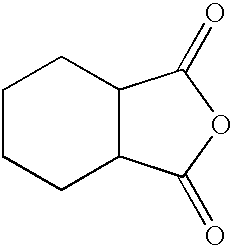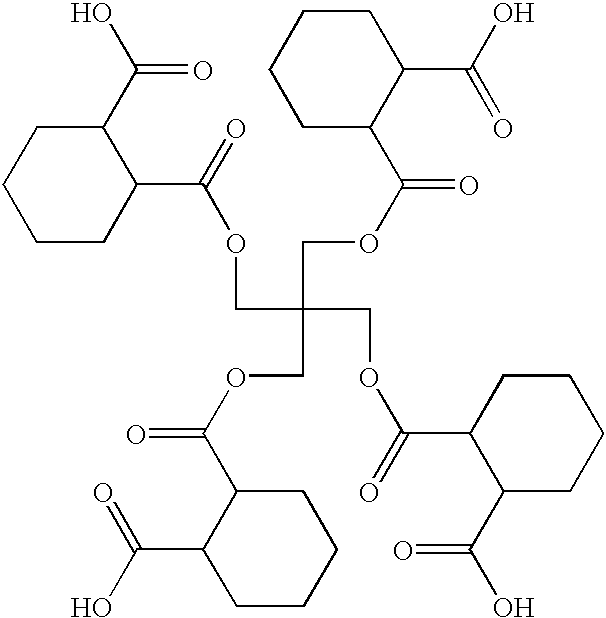Polymeric pigment dispersant utilized as a grind resin for pigments in solventborne pigment dispersions and method of preparing the same
a polymer pigment and dispersant technology, applied in the field of pigment dispersions, can solve the problems of ineffective inadequate grind resins of prior art including polyacrylic-based resins, and insufficient time for grinding, and achieves good color travel, low molecular weight, and good color travel
- Summary
- Abstract
- Description
- Claims
- Application Information
AI Technical Summary
Benefits of technology
Problems solved by technology
Method used
Image
Examples
example 1
[0053]In Example 1, the polyester polycarbamate polymeric pigment dispersant was prepared by adding and reacting the following parts, by weight, unless otherwise indicated.
[0054]
TABLE 1AmountAmountWeightReactant(moles)(grams)(%)pentaerythritol1.0 136.0 6.6[PE]hexahydrophthalic anhydride4.0 616.029.7[HHPA]glycidylneodecanoate4.0 992.047.8[CARDURA E 10S]methyl carbamate4.4 330.015.9TOTAL—2074.0100.0
[0055]Per the above table, Table 1, 616.0 grams of HHPA were added in a reaction flask to 136.0 grams of PE, i.e., the branched compound, to form the first intermediate compound. The reaction flask, including the PE and HHPA, was heated with a conventional heat supply to a temperature of 120° C. to 125° C., when an exotherm was observed, peaking at approximately 150° to 160° C. After this exotherm, the batch was allowed to cool and was maintained at 140° C. for approximately one hour. Standard titration for acid number revealed that the reaction to form the first intermediate compound was ...
example 2
[0056]In Example 2, the polyester polycarbamate polymeric pigment dispersant was prepared by adding and reacting the following parts, by weight, unless otherwise indicated.
[0057]
TABLE 2AmountAmountWeightReactant(moles)(grams)(%)pentaerythritol1.0 136.0 3.7[PE]dimethylolpropionic acid4.0 536.014.6[DMPA]hexahydrophthalic anhydride6.0 924.025.1[HHPA]glycidylneodecanoate6.01488.040.4[CARDURA E 10S]methyl carbamate8.0 600.016.2TOTAL—3684.0100.0
[0058]Per the above table, Table 2, 536.0 grams DMPA were added in a reaction flask to 136.0 grams of PE to form the branched compound. 0.2 grams of H2SO4 were used to catalyze this reaction. The reaction flask, including the PE and DMPA, was heated with a conventional heat supply to a temperature of 120° C. and then to 160° C. Condensation took place and 72 grams of water were removed, with about the last 10 grams of water removed under vacuum. 924.0 grams of HHPA were then added to the branched compound to form the first intermediate compound up...
example 3
[0059]In Example 3, the polyester polycarbamate polymeric pigment dispersant was prepared by adding and reacting the following parts, by weight, unless otherwise indicated.
[0060]
TABLE 3AmountAmountWeightReactant(moles)(grams)(%)pentaerythritol1.0 136.0 4.1[PE]dimethylolpropionic acid4.0 536.016.3[DMPA]hexahydrophthalic anhydride5.0 770.023.5[HHPA]glycidylneodecanoate5.01240.037.8[CARDURA E 10S]methyl carbamate8.0 600.018.3TOTAL—3282.0100.0
[0061]Per the above table, Table 3, 536.0 grams DMPA were added in a reaction flask to 136.0 grams of PE to form the branched compound. 0.2 grams of H2SO4 were used to catalyze this reaction. The reaction flask, including the PE and DMPA, was heated with a conventional heat supply to a temperature of 120° C. and then to 160° C. Condensation took place and 72 grams of water were removed, with about the last 10 grams of water removed under vacuum. 770.0 grams of HHPA were then added to the branched compound to form the first intermediate compound up...
PUM
| Property | Measurement | Unit |
|---|---|---|
| temperature | aaaaa | aaaaa |
| temperature | aaaaa | aaaaa |
| temperatures | aaaaa | aaaaa |
Abstract
Description
Claims
Application Information
 Login to View More
Login to View More - R&D
- Intellectual Property
- Life Sciences
- Materials
- Tech Scout
- Unparalleled Data Quality
- Higher Quality Content
- 60% Fewer Hallucinations
Browse by: Latest US Patents, China's latest patents, Technical Efficacy Thesaurus, Application Domain, Technology Topic, Popular Technical Reports.
© 2025 PatSnap. All rights reserved.Legal|Privacy policy|Modern Slavery Act Transparency Statement|Sitemap|About US| Contact US: help@patsnap.com



